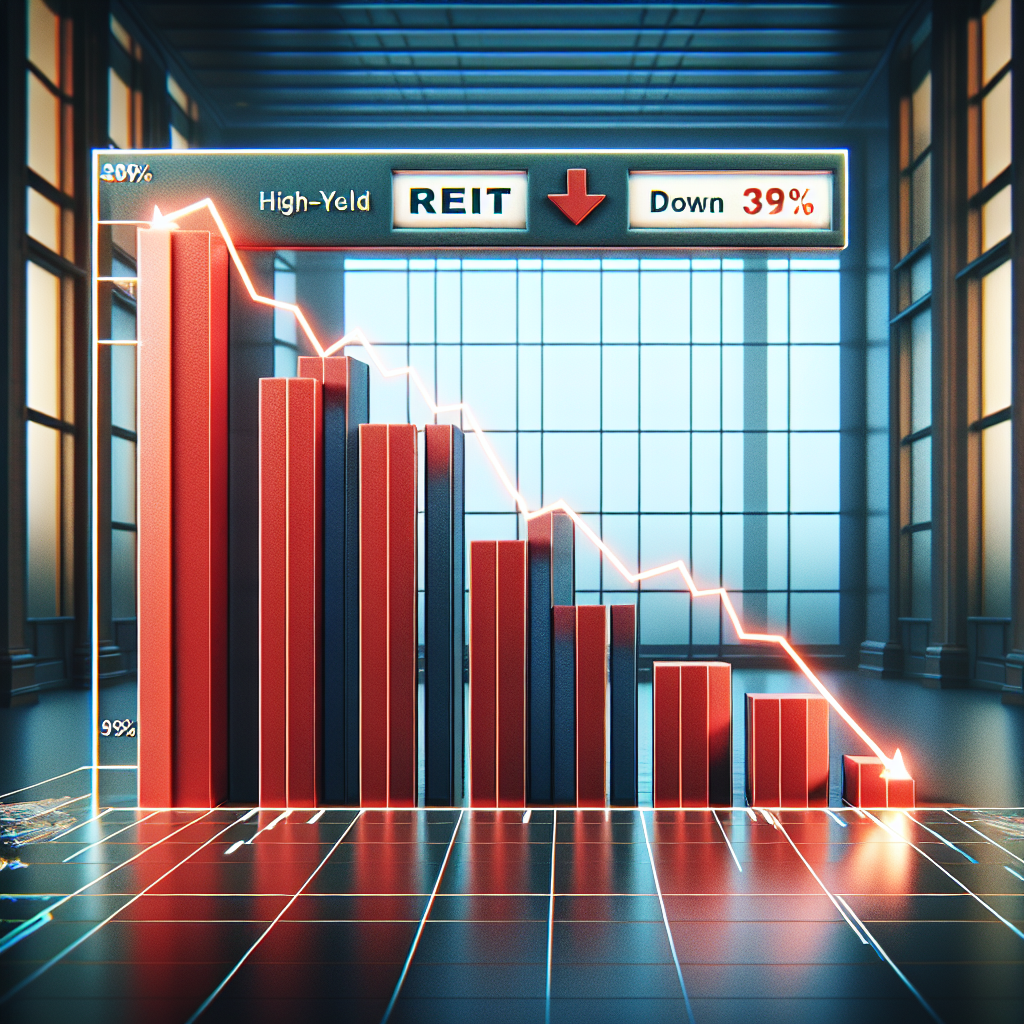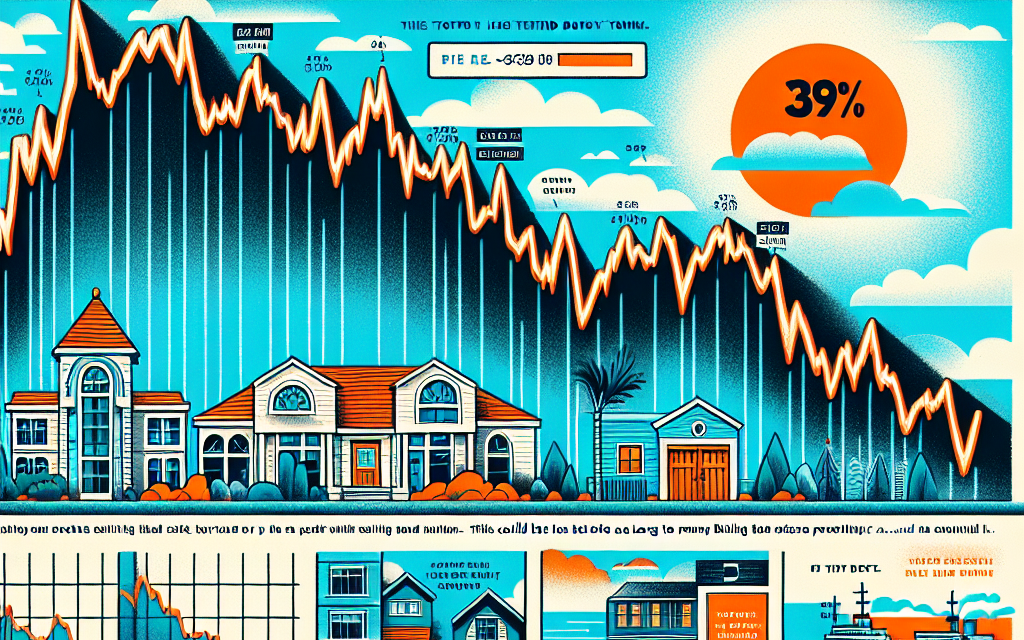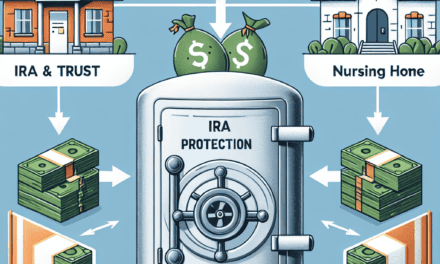“Seize the Dip: Invest in Tomorrow’s High-Yield REIT Today!”
Introduction
**Introduction:**
In the ever-evolving landscape of real estate investment trusts (REITs), market fluctuations often present unique opportunities for discerning investors. One such opportunity has emerged with a top high-yield REIT stock that has recently experienced a significant decline of 39%. While such a drop might initially raise concerns, it also opens the door for potential long-term gains for those willing to look beyond short-term volatility. This REIT, known for its robust dividend yield and strategic asset portfolio, now offers an attractive entry point for investors seeking both income and growth. As we delve into the factors contributing to its current valuation and future prospects, it becomes evident why this REIT could be a compelling addition to a diversified investment portfolio.
Understanding The Current Market Conditions For High-Yield REITs
In recent times, the real estate investment trust (REIT) sector has experienced significant fluctuations, with some high-yield REIT stocks witnessing substantial declines in their market value. One such stock, which has seen a 39% drop, presents a potential long-term buying opportunity for discerning investors. To understand why this might be the case, it is essential to delve into the current market conditions affecting high-yield REITs and explore the factors contributing to their recent performance.
The broader economic landscape has been marked by rising interest rates, inflationary pressures, and geopolitical uncertainties, all of which have had a profound impact on the real estate market. High-yield REITs, in particular, are sensitive to interest rate changes because they often rely on debt financing to fund their operations and growth. As interest rates rise, the cost of borrowing increases, potentially squeezing profit margins and affecting dividend payouts. Consequently, investors may become wary, leading to a sell-off in REIT stocks.
However, it is crucial to recognize that not all REITs are equally affected by these macroeconomic factors. Some high-yield REITs possess robust business models and strong fundamentals that enable them to weather economic storms more effectively than others. For instance, REITs with diversified portfolios, long-term lease agreements, and properties in high-demand locations are better positioned to maintain stable cash flows and continue delivering attractive yields to investors.
Moreover, the recent decline in the stock price of certain high-yield REITs may not necessarily reflect their intrinsic value. Market sentiment can often drive stock prices in the short term, creating discrepancies between a company’s market valuation and its underlying worth. This misalignment can present a compelling opportunity for long-term investors who are willing to look beyond the immediate market volatility and focus on the REIT’s potential for future growth and income generation.
In addition to market conditions, it is important to consider the specific attributes of the REIT in question. A thorough analysis of its financial health, management team, and strategic initiatives can provide valuable insights into its long-term prospects. For example, a REIT with a strong balance sheet, prudent capital allocation strategies, and a track record of consistent dividend payments is likely to be more resilient in the face of economic challenges.
Furthermore, the real estate sector is inherently cyclical, and downturns can often be followed by periods of recovery and growth. As the economy stabilizes and interest rates eventually normalize, high-yield REITs with solid fundamentals may experience a rebound in their stock prices. This potential for capital appreciation, combined with the ongoing income from dividends, makes them an attractive option for investors seeking both growth and income.
In conclusion, while the current market conditions for high-yield REITs are challenging, they also present opportunities for those willing to adopt a long-term perspective. By carefully evaluating the specific characteristics of a REIT and considering the broader economic context, investors can identify stocks that are undervalued and poised for recovery. The 39% decline in the stock price of a top high-yield REIT may indeed represent a buying opportunity for those who are prepared to navigate the complexities of the market and capitalize on the potential for future gains.
Analyzing The Factors Behind The 39% Decline In REIT Stock
The recent 39% decline in the stock price of a prominent high-yield Real Estate Investment Trust (REIT) has caught the attention of investors and analysts alike, prompting a closer examination of the factors contributing to this downturn. Understanding these elements is crucial for those considering whether this REIT represents a long-term buying opportunity. To begin with, the broader economic environment has played a significant role in the stock’s decline. Rising interest rates, implemented by central banks to combat inflation, have increased the cost of borrowing. This, in turn, affects REITs, which often rely on debt to finance their property acquisitions and development projects. As borrowing costs rise, the profitability of these investments can be squeezed, leading to a negative impact on stock prices.
Moreover, the real estate sector itself has faced challenges that have further pressured REIT valuations. The ongoing shift in consumer behavior, accelerated by the COVID-19 pandemic, has led to changes in demand for different types of real estate. For instance, the retail sector has been hit hard as e-commerce continues to grow, reducing the need for physical retail spaces. Similarly, the office space market is undergoing a transformation as remote work becomes more prevalent, leading to uncertainty about future demand. These sector-specific challenges have contributed to the decline in the stock price of REITs with significant exposure to retail and office properties.
In addition to these macroeconomic and sector-specific factors, company-specific issues have also played a part in the stock’s decline. Management decisions, such as strategic missteps or poor execution of business plans, can erode investor confidence. For instance, if a REIT has made aggressive acquisitions at high valuations, it may struggle to generate the expected returns, leading to a reassessment of its stock value. Furthermore, any perceived lack of transparency or communication from management can exacerbate investor concerns, resulting in a sell-off.
Despite these challenges, it is important to consider the potential for a long-term buying opportunity. REITs are known for their ability to generate steady income through dividends, which can be particularly attractive in a low-yield environment. The current decline in stock price may present an attractive entry point for investors seeking high yields. Additionally, the underlying assets of REITs, such as real estate properties, often appreciate over time, providing potential for capital gains.
Furthermore, the long-term outlook for real estate remains positive, driven by factors such as population growth and urbanization. As economies recover and adapt to new trends, demand for certain types of real estate, such as logistics centers and data centers, is expected to rise. REITs that are well-positioned to capitalize on these trends may experience significant growth in the future.
In conclusion, while the 39% decline in this high-yield REIT stock is concerning, it is essential to analyze the underlying factors contributing to this downturn. By understanding the impact of macroeconomic conditions, sector-specific challenges, and company-specific issues, investors can make informed decisions about the potential for a long-term buying opportunity. As with any investment, it is crucial to conduct thorough research and consider one’s risk tolerance before making a decision.
Evaluating The Long-Term Growth Potential Of High-Yield REITs
In the ever-evolving landscape of real estate investment trusts (REITs), identifying opportunities for long-term growth is crucial for investors seeking to maximize returns. One such opportunity has emerged with a high-yield REIT stock that has recently experienced a significant decline of 39%. While this downturn may initially appear concerning, it presents a compelling case for a long-term buy opportunity, particularly for those who understand the intricacies of the REIT market and are willing to navigate its inherent volatility.
To begin with, it is essential to understand the factors contributing to the stock’s decline. Market fluctuations, interest rate changes, and economic uncertainties often impact REITs, given their sensitivity to macroeconomic conditions. However, these factors do not necessarily reflect the underlying value or potential of the REIT itself. In this context, the recent decline may be attributed to broader market trends rather than any fundamental weaknesses within the REIT. Consequently, this presents a unique opportunity for investors to acquire shares at a discounted price, potentially reaping substantial rewards as the market stabilizes.
Moreover, the high-yield nature of this REIT is a significant factor to consider. High-yield REITs are known for their ability to generate substantial income through dividends, making them attractive to income-focused investors. Despite the recent decline, the REIT’s ability to maintain its dividend payouts is a testament to its financial resilience and operational efficiency. This consistent income stream can provide a buffer against market volatility, offering investors a degree of stability in uncertain times.
Furthermore, evaluating the long-term growth potential of this REIT requires a closer examination of its portfolio and strategic positioning. A diversified portfolio across various real estate sectors, such as commercial, residential, and industrial properties, can mitigate risks associated with sector-specific downturns. Additionally, a focus on high-demand geographic locations can enhance the REIT’s growth prospects, as these areas are more likely to experience appreciation in property values and rental income. By strategically positioning itself in growth markets, the REIT can capitalize on favorable demographic and economic trends, thereby enhancing its long-term value proposition.
In addition to portfolio diversification, the REIT’s management team plays a crucial role in driving growth. A competent and experienced management team can effectively navigate market challenges, optimize asset performance, and identify new investment opportunities. Their ability to execute strategic initiatives, such as property acquisitions, developments, and renovations, can significantly impact the REIT’s growth trajectory. Therefore, assessing the management team’s track record and strategic vision is vital in evaluating the REIT’s long-term potential.
Finally, it is important to consider the broader economic outlook and its implications for the real estate market. While short-term uncertainties may persist, the long-term fundamentals of the real estate sector remain robust. Population growth, urbanization, and technological advancements continue to drive demand for real estate assets, providing a solid foundation for REITs to thrive. As the economy recovers and stabilizes, REITs with strong fundamentals and strategic positioning are well-positioned to benefit from these trends.
In conclusion, the recent 39% decline in this high-yield REIT stock should not deter investors but rather be viewed as a potential long-term buy opportunity. By carefully evaluating the REIT’s portfolio, management team, and market positioning, investors can make informed decisions that align with their investment objectives. While market volatility is an inherent aspect of investing in REITs, the potential for substantial returns and consistent income makes them an attractive option for those with a long-term investment horizon.
Key Metrics To Consider When Investing In REIT Stocks

When considering investments in Real Estate Investment Trusts (REITs), particularly those that have experienced significant price declines, it is crucial to evaluate key metrics that can provide insight into their long-term potential. A REIT stock that has recently caught the attention of investors is one that has seen a 39% drop in its market value, yet offers a high yield. This presents a potential buying opportunity for those with a long-term investment horizon. To make an informed decision, investors should focus on several critical metrics that can help assess the viability and future performance of such REITs.
First and foremost, the Funds from Operations (FFO) is a pivotal metric to consider. FFO provides a clearer picture of a REIT’s cash-generating capabilities by adding depreciation and amortization back to earnings, as these are non-cash expenses. A consistent or growing FFO indicates that the REIT is effectively managing its properties and generating stable income, which is essential for sustaining dividend payments. In the case of a REIT with a significant price drop, analyzing the FFO can help determine whether the decline is due to temporary market conditions or underlying operational issues.
Another important metric is the dividend yield, which is particularly relevant for income-focused investors. A high dividend yield can be attractive, but it is essential to assess its sustainability. This involves examining the payout ratio, which compares the dividends paid to the FFO. A payout ratio that is too high may indicate that the REIT is overextending itself to maintain its dividend, potentially leading to future cuts. Conversely, a reasonable payout ratio suggests that the REIT can comfortably support its dividend payments, even in challenging market conditions.
Additionally, the Net Asset Value (NAV) is a critical measure of a REIT’s intrinsic value. By comparing the market price of the REIT to its NAV, investors can gauge whether the stock is undervalued or overvalued. A REIT trading below its NAV might indicate a buying opportunity, especially if the underlying assets are of high quality and the market has overreacted to short-term challenges. However, it is important to conduct a thorough analysis of the REIT’s property portfolio, including location, occupancy rates, and lease terms, to ensure that the NAV accurately reflects the potential for future growth.
Leverage is another factor that warrants careful consideration. A REIT’s debt levels can significantly impact its financial stability and ability to weather economic downturns. The debt-to-equity ratio provides insight into the REIT’s capital structure and risk profile. A high level of debt may increase the risk of financial distress, particularly if interest rates rise or property values decline. Therefore, investors should look for REITs with manageable debt levels and a history of prudent financial management.
Finally, market trends and economic conditions play a vital role in the performance of REITs. Factors such as interest rates, inflation, and real estate market dynamics can influence a REIT’s profitability and growth prospects. Staying informed about these external factors can help investors anticipate potential challenges and opportunities in the REIT sector.
In conclusion, while a high-yield REIT stock that has declined by 39% may present an enticing long-term investment opportunity, it is essential to conduct a comprehensive analysis of key metrics. By evaluating FFO, dividend yield, NAV, leverage, and market conditions, investors can make informed decisions and potentially capitalize on undervalued opportunities in the REIT market.
Comparing High-Yield REITs With Other Investment Options
In the realm of investment opportunities, Real Estate Investment Trusts (REITs) have long been a favored choice for those seeking both income and diversification. Among these, high-yield REITs stand out, offering investors the potential for substantial returns. However, the volatility inherent in the market can sometimes lead to significant price fluctuations, as evidenced by a top high-yield REIT stock currently down 39%. This decline, while concerning at first glance, may present a compelling long-term buy opportunity for discerning investors. To fully appreciate this potential, it is essential to compare high-yield REITs with other investment options, considering both their advantages and inherent risks.
High-yield REITs are particularly attractive due to their ability to generate consistent income through dividends. By law, REITs must distribute at least 90% of their taxable income to shareholders, making them a reliable source of cash flow. This characteristic is especially appealing in a low-interest-rate environment, where traditional fixed-income investments such as bonds may offer limited returns. Furthermore, REITs provide exposure to the real estate market without the need for direct property ownership, thus allowing investors to benefit from property appreciation and rental income.
In contrast, other investment options, such as stocks and mutual funds, offer different risk-reward profiles. Stocks, for instance, can provide significant capital appreciation but often come with higher volatility and no guaranteed income. Mutual funds, while offering diversification, may not deliver the same level of income as high-yield REITs, particularly in sectors outside of real estate. Therefore, for income-focused investors, high-yield REITs can serve as a valuable component of a diversified portfolio.
However, it is crucial to acknowledge the risks associated with high-yield REITs. Market fluctuations, interest rate changes, and economic downturns can all impact the performance of REITs. The recent 39% decline in the value of a top high-yield REIT stock underscores the importance of conducting thorough due diligence before investing. Investors must assess the underlying assets, management quality, and financial health of the REIT to ensure it aligns with their investment goals and risk tolerance.
Despite these risks, the current downturn in the REIT’s stock price may offer a strategic entry point for long-term investors. Historically, market corrections have often been followed by periods of recovery and growth, particularly for well-managed REITs with strong fundamentals. By purchasing shares at a reduced price, investors can potentially enhance their future returns as the market stabilizes and the REIT’s value rebounds.
Moreover, the long-term outlook for real estate remains positive, driven by factors such as population growth, urbanization, and the increasing demand for commercial and residential properties. As such, high-yield REITs are well-positioned to capitalize on these trends, providing investors with both income and capital appreciation over time.
In conclusion, while the recent decline in a top high-yield REIT stock may initially appear daunting, it is essential to view it within the broader context of investment opportunities. By comparing high-yield REITs with other options, investors can better understand their unique benefits and risks. For those with a long-term perspective and a willingness to navigate market volatility, this downturn may indeed represent a promising buy opportunity, offering the potential for substantial returns in the years to come.
Risk Management Strategies For Investing In Volatile REIT Markets
Investing in Real Estate Investment Trusts (REITs) can be a lucrative endeavor, particularly when focusing on high-yield options. However, the inherent volatility of the REIT market necessitates a robust risk management strategy to safeguard investments. This becomes especially pertinent when considering a top high-yield REIT stock that has recently experienced a 39% decline. While such a drop might initially deter investors, it can also present a compelling long-term buying opportunity for those equipped with effective risk management strategies.
To begin with, diversification remains a cornerstone of risk management in volatile markets. By spreading investments across various sectors and geographic locations, investors can mitigate the impact of a downturn in any single area. For instance, if a particular REIT is heavily invested in retail properties, a downturn in the retail sector could significantly affect its performance. However, by diversifying into other sectors such as healthcare or industrial properties, investors can cushion the blow of sector-specific volatility. This approach not only reduces risk but also enhances the potential for stable returns over time.
Moreover, understanding the underlying assets of a REIT is crucial. Investors should conduct thorough due diligence to assess the quality and location of the properties within a REIT’s portfolio. Properties in prime locations with high demand are likely to maintain their value better during market fluctuations. Additionally, evaluating the management team’s track record can provide insights into their ability to navigate challenging market conditions. A competent management team with a history of prudent decision-making can be a significant asset in times of volatility.
Another essential strategy is to maintain a long-term perspective. Market volatility can lead to short-term price fluctuations that may not accurately reflect the intrinsic value of a REIT. By focusing on the long-term potential and income-generating capabilities of a REIT, investors can avoid the pitfalls of making impulsive decisions based on short-term market movements. This approach aligns with the fundamental principle of investing: buying quality assets at a discount and holding them for the long term.
Furthermore, investors should pay close attention to interest rate trends. REITs are particularly sensitive to interest rate changes, as rising rates can increase borrowing costs and reduce the attractiveness of dividend yields compared to fixed-income securities. By monitoring interest rate forecasts and adjusting their portfolios accordingly, investors can better position themselves to weather interest rate-induced volatility.
Additionally, maintaining liquidity is a vital component of risk management. Having a portion of the investment portfolio in liquid assets allows investors to take advantage of buying opportunities during market downturns without the need to sell existing holdings at a loss. This flexibility can be particularly advantageous when a high-yield REIT stock experiences a significant price drop, as it enables investors to capitalize on potential long-term gains.
In conclusion, while the recent 39% decline in a top high-yield REIT stock may raise concerns, it also underscores the importance of effective risk management strategies in volatile markets. By diversifying investments, understanding the underlying assets, maintaining a long-term perspective, monitoring interest rate trends, and ensuring liquidity, investors can navigate the complexities of the REIT market with greater confidence. Ultimately, these strategies not only help mitigate risk but also position investors to seize opportunities that arise from market volatility, potentially leading to substantial long-term rewards.
Expert Opinions On The Future Of High-Yield REIT Investments
In the ever-evolving landscape of real estate investment trusts (REITs), investors are constantly on the lookout for opportunities that promise substantial returns. One such opportunity has emerged with a high-yield REIT stock that has recently experienced a significant decline of 39%. While such a drop might initially raise concerns, expert opinions suggest that this could, in fact, represent a compelling long-term buy opportunity for discerning investors.
To begin with, it is essential to understand the factors contributing to the stock’s decline. Market volatility, interest rate fluctuations, and sector-specific challenges have all played a role in the recent downturn. However, seasoned investors recognize that these factors, while impactful in the short term, do not necessarily reflect the intrinsic value or long-term potential of the REIT. Instead, they often present a chance to acquire shares at a discounted price, setting the stage for future gains.
Moreover, the fundamentals of the REIT in question remain robust. Despite the recent dip, the underlying assets continue to generate steady cash flows, supported by long-term leases and a diversified tenant base. This stability is crucial, as it ensures that the REIT can maintain its high dividend yield, which is a primary attraction for income-focused investors. Furthermore, the management team has demonstrated a strong track record of navigating market challenges, implementing strategic initiatives to enhance asset value, and optimizing operational efficiency.
In addition to these solid fundamentals, the broader economic environment offers reasons for optimism. As the global economy gradually recovers from recent disruptions, demand for commercial real estate is expected to rebound. This recovery is likely to be driven by factors such as urbanization, e-commerce growth, and the resurgence of travel and hospitality sectors. Consequently, REITs with well-positioned portfolios stand to benefit from these trends, potentially leading to capital appreciation and increased dividend payouts.
Transitioning to the perspective of expert analysts, many emphasize the importance of a long-term investment horizon when considering high-yield REITs. They argue that while short-term market fluctuations can be unsettling, they often create opportunities for patient investors to capitalize on undervalued assets. By focusing on the REIT’s ability to generate consistent income and its potential for growth, investors can mitigate the impact of temporary setbacks and position themselves for future success.
Furthermore, diversification within the REIT sector can enhance an investor’s portfolio resilience. By allocating capital across various property types and geographic regions, investors can reduce exposure to sector-specific risks and benefit from different market dynamics. This strategy not only provides a buffer against volatility but also allows investors to capture opportunities in emerging markets and sectors poised for growth.
In conclusion, while the 39% decline in this high-yield REIT stock may initially appear daunting, expert opinions suggest that it represents a promising long-term buy opportunity. By focusing on the REIT’s strong fundamentals, the potential for economic recovery, and the benefits of diversification, investors can navigate the current market landscape with confidence. As always, conducting thorough due diligence and maintaining a disciplined investment approach will be key to unlocking the full potential of high-yield REIT investments.
Q&A
1. **What is the name of the REIT stock that is down 39%?**
– The specific name of the REIT stock is not provided.
2. **What is the current dividend yield of this REIT stock?**
– The dividend yield is typically high, but the exact percentage is not specified.
3. **What factors have contributed to the stock’s 39% decline?**
– Factors may include market volatility, interest rate hikes, or sector-specific challenges.
4. **Why is this REIT considered a long-term buy opportunity?**
– It may have strong fundamentals, potential for recovery, or attractive valuation.
5. **What are the key risks associated with investing in this REIT?**
– Risks could include economic downturns, rising interest rates, or operational challenges.
6. **What is the REIT’s strategy for growth or recovery?**
– The strategy might involve asset management, acquisitions, or cost optimization.
7. **How does this REIT compare to its peers in the industry?**
– It may offer a higher yield, better growth prospects, or a more diversified portfolio.
Conclusion
The significant 39% decline in the stock price of this high-yield REIT presents a compelling long-term buying opportunity for investors. Despite the recent downturn, the fundamentals of the REIT remain strong, with a robust portfolio of assets, consistent cash flow, and a commitment to maintaining or growing its dividend payouts. The current market conditions may have temporarily impacted its valuation, but the underlying business model and strategic positioning suggest potential for recovery and growth. Investors with a long-term perspective could benefit from the attractive entry point, capitalizing on both the high yield and potential capital appreciation as market conditions stabilize.





